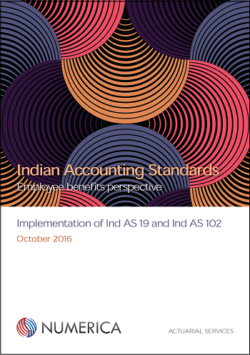
Ind AS 19 should be a welcome news for most companies, as the P&L statement will become very stable, as compared with AS 15, and the actuarial losses will flow through the OCI.
For companies coming under the ambit of Indian Accounting Standards (Ind AS), the transition from AS 15 is expected to be challenging and the impact could be significant.
From an employee benefits perspective, the reporting requirements will change from AS 15 to Ind AS 19. Ind AS 102 will be applicable for share based benefits, but that is not covered in this post.
Ind AS 19 will bring about many changes in how employee benefits reporting is carried out. This post sets out three most important differences between AS 15 and Ind AS 19, and how companies will be affected by them. It is worth noting at this point that these changes only affect ‘post-employment benefits’ such as gratuity and pension, whereas ‘other long-term benefits’ (OLTB) will not be affected by Ind AS 19. Most leave benefit schemes fall within the OLTB category.
1. IND AS 19 introduces Other Comprehensive Income, or OCI
A part of what was P&L expense will be reported as OCI under Ind AS 19. Overall, the sum of P&L expense and OCI under Ind AS 19 will remain the same as P&L under AS 15.
The concept of OCI did not exist under AS 15. To consider the impact this will have on a reporting company, let’s first understand how P&L expense is calculated under AS 15.
AS 15 P&L statement consists of several elements, such as current service cost, interest cost, expected return on assets and actuarial losses. Ind AS 19 separates these elements into P&L statement and OCI. Generally speaking, for unfunded schemes, actuarial losses will be reported under OCI, and all other elements would continue to be part of the P&L statement. For funded schemes, an additional amount could be attributed to OCI from P&L statement, as explained in the next section. Note that the actuarial gains and losses are referred to as ‘remeasurements’ under Ind AS 19.
Impact on reporting companies:
The introduction of OCI will make the P&L statement significantly more stable.
2. IND AS 19 introduces the concept of Net Interest Cost
Expected return on assets (ERA) and interest cost will be comined into one measure ‘net interest cost’. It will be calculated as interest on opening deficit, where ‘interest rate’ will be the beginning of year discount rate.
Net interest cost is a new concept under Ind AS 19. However, as with OCI, this measure can be matched and compared with other measures of AS 15 to understand the impact on the financial position of a company.
For a general understanding of actuarial valuations and related concepts such as DBO, click here.
Ind AS 19 net interest cost is the difference between interest on Defined Benefit Obligation (DBO) and interest on assets. Interest on DBO, can be directly compared with ‘interest cost‘ under AS 15, and barring small timing related differences, these two will largely be the same. Interest on assets can be compard with ‘expected return on assets’ (ERA). While the latter was calculated by making an explicit assumption on the expected rate of return, the corresponding Ind AS 19 measure is just based on the opening discount rate.
In order to undertsand the impact of this change on the P&L statement of the reporting company, one would need to understand how the opening discount rate compares with the actual rate of return earned during the reporting period.
If you are wondering that ‘expected return’ rather than actual return should be the right measure to compare against, then an explanation follows.
ERA plus actuarial gain on assets equals actual return. Both ERA and actuarial gains are reported under P&L statement of AS 15. So effectively, it is the actual return on assets that affects the P&L expense, not the ERA. I have provided more explanation around this topic in another post.
The P&L expense under Ind AS 19 will be lower than under AS 15 if the discount rate at the beginning of the period was higher than the actual return (remember that ERA, actual return and interest on assets are all negative numbers and act to reduce the P&L expense).
Impact on reporting companies:
Under AS 15, the interest cost and actual return were two different things, behaving independently of each other. This meant that the impact of a change in discount rate may not be offset by the investment return earned. This caused volatility in the P&L statement. Under Ind AS 19, the finance costs on both assets and DBO are calculated based on discount rate only. This should act to further reduce the P&L volatility.
3. IND AS 19 introduces additional disclosures
Additional calculations and disclosures will be required. Most importantly, sensitivities of DBO to changes in certain actuarial assumptions will need to be disclosed.
Ind AS 19 has introduced additional disclosures that focus on risk management aspects of the scheme. These include:
- Sensitivities of DBO to significant actuarial assumptions
- An explanation of material risks facing the benefit schemes and how they are managed
It is important to note that sensitivities need to demonstrate the impact on DBO rather than net liability position, which is DBO less the fund assets.
Deciding which assumptions are ‘significant’ will require some judgement. For schemes such as gratuity, only the discount rate and salary escalation could be significant, whereas for a pension scheme, post-retirement mortality would be the most material. For the first implementation, it is recommended to carry out sensitivities on a vareity of different assumptions to ascertain the materiality. For subsequent assessments, only those assumptions that are found to be material can be included in sensitivity analyses.
Explanation of risk management practices of benefit schemes would entail whether the scheme is funded, the types of assets the scheme holds and an explanation about how the scheme surplus or deficit will change in response to changes in macroeconomic variables. It would also include an explanation of the insurance arrangements.
Impact on reporting companies:
There will be no specific immediate financial impact because of this change.
Download our white paper on transitioning to Indian Accounting Standards from an employee benefits perspective by clicking the picture below:


January 03, 2018 at 3:21 pm, Impact of increase in gratuity limit on actuarial liability • Numerica said:
[…] For more information on differences between AS 15 and Ind AS 19, refer to this post. […]